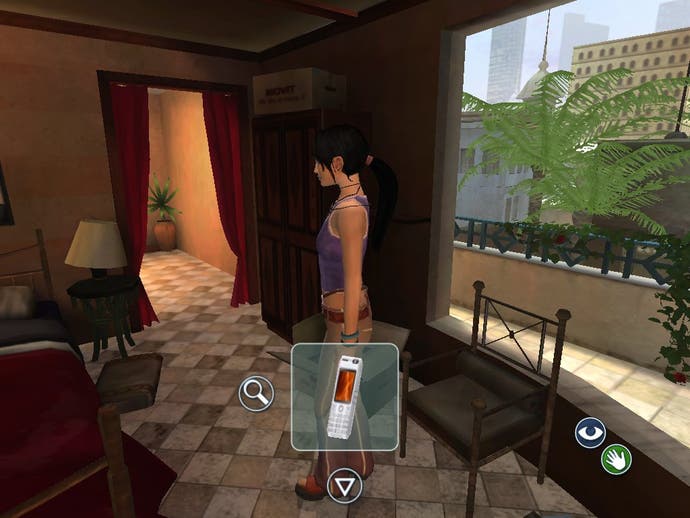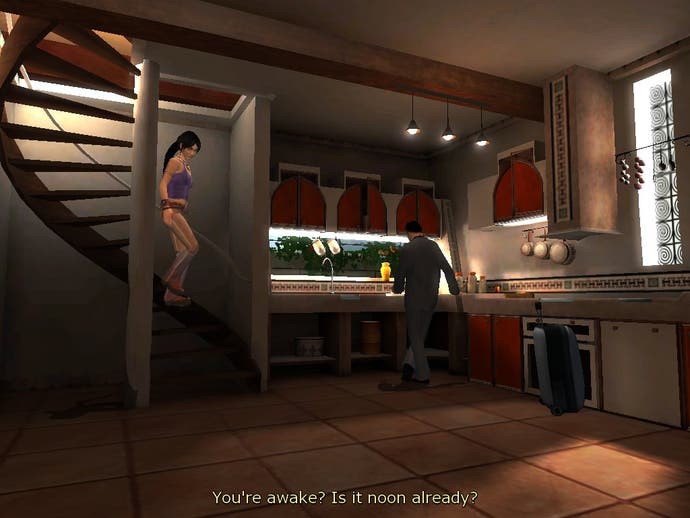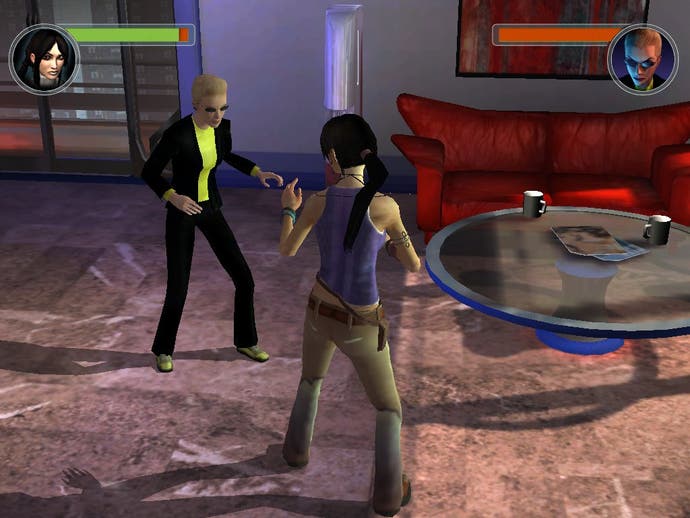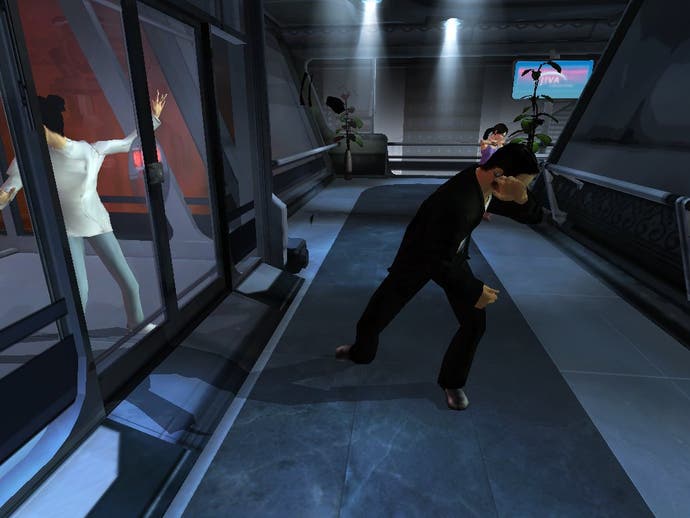Dreamfall: The Longest Journey
Keeping the spirit of adventure gaming alive on PC and Xbox.
Is the adventure game dead, or has it merely evolved? There's little doubt that the traditional 'point and click' style is now commercially dead at least; the last rites surely having been administered when LucasArts declared the (apparently rubbish action adventure travesty) Full Throttle 2 and Sam & Max: Freelance Police unworthy of an apathetic audience - or perhaps it was the other way round. They may have got that call badly wrong, but when rivals Revolution failed to hit big with the THQ-published Broken Sword: The Sleeping Dragon, you could concede they may have been right to play safe. Rightly or wrongly, the vast majority of buying public just doesn't seem to care for deep, involving, narrative-heavy games anymore. Even Silent Hill and Resident Evil - the last big-name concessions to puzzle-rich narrative-heavy adventuring - have become far more action-oriented in their respective fourth incarnations.
But not everyone sees it that way. Five years ago The Longest Journey emerged to rapturous acclaim at a time when the adventure game was still - just about - a genre that piqued the public's interest. After 18 months in development, last week Norwegian developer Funcom finally took the wraps off its latest work-in-progress build of Dreamfall: The Longest Journey, taking us through the first section of this 'action adventure' game to give an overview of what to expect in this long-awaited sequel.
Action stations

First of all, adventure fans needn't panic too much at the sight of the 'action' in their adventure, for while it does have action set-pieces (with hand-to-hand combat, for example), the central gameplay premise is still very much based on investigative intrigue, full of rich conversations, lateral thinking, lavish and atmospheric locations and all the components adventure fans will love without alienating the mainstream fans of traditional action based titles.
Set in the same 'universe' as the original (and once again directed by Ragnar Tørnquist), Dreamfall is based around a similarly "epic blend of near future science fiction and magical fantasy" and takes place in three different - but connected - worlds: Stark, which is basically Earth in 2219; Arcadia, a magical fantasy world; and the mystical Winter.
Not wishing to give too much away at present, Funcom shows the game's intro sequence, where a man walks into a Tibetan ritual in the 1930s and for reasons that will presumably become apparent gets bathed in light and probably whisked off to another dimension.
Girlfriend in a coma

But the first chapter gets underway properly from the perspective of Zoë Castillo, one of the three playable characters in the game. Her story kicks off with her apparently in a coma, with her father Gabriel by her side in the bedroom talking softly to her and hoping that she can hear him.
"We wanted to set the mood here and lull the player into a sense of well being. You're in Casablanca, Africa. The Earth has changed, Europe is in a shambles, the US is run by a corporation, and Africa has become the superpower," Funcom's Jørgen Tharaldsen explains. "We take the story back six weeks before Zoë ended up this way - we compare the first chapter to a good thriller, building layer on layer to get to a grand finale.
"So, you start off at Zoë's family house. She's just come back from Cape Town having just broken up with her boyfriend, and is really at a crossroads for her future - this is where you come in.
"You start off in the bedroom, and like much of the game there's really no time pressure. We're trying to bridge the classic point and click," Tharaldsen asserts, "so you can just look around and find out different things, and if you want you can look at the pictures in room and get used to the controls."
Return to splendour

"We're trying to focus strongly on ambience, to create a believable universe," offers Tharaldsen, demonstrating the new console pad control system that uses the right stick to focus a cone of light around the room ("If there's something to interact with an icon comes up")."We think this makes the exploration more interesting, and have invested a high attention to detail to give the player lots of info to flesh out the details of the world," adds Tharaldsen. The level of graphical splendour and attention to detail is, as expected, lavish. Fans of detailed, atmospheric scenes will be in their element.
Much like any traditional adventure, a fair chunk of the back story and snippets of incidental information is locked away in the objects and locations you visit, and as such the game relies on a much slower pace to let the player really soak up what's around you. Using an Xbox pad plugged into his PC, it's apparent that the console command interface will be slick and intuitive, with blue for descriptions, green for the 'cinematic' camera, and green to carry out context sensitive actions.
In a nod to Japanese cult horror classic 'Ring', Zoë keeps catching a glimpse of grainy video footage that keeps appearing on TVs and monitors whenever she's nearby, showing a little girl with long dark hair apparently pleading for help. "Find her, save her," the message says. Creepy. Initially Zoë assumes it's 'static on the wire', but the second and third time it happens, the penny begins to drop. Annoyingly, no one else present seems to be in a position to see it at the time.
We built this city on sausage rolls

Taking us through the remainder of the opening chapter, Zoë ambles down to the nearby gym heading out into the Casablanca of the future - "the most boring street in the world," according to the lead heroine. "We tried to take the way it looks and spice it up," Tharaldsen explains. "There's a stunning cityscape, with a bigger landscape and taller buildings, but humans are still humans."
Once at the gym Zoë hooks up with her friend Olivia, giving us the first example of the conversation system in the game. Using the standard multiple choice mechanic, it's a straightforward continuation of what adventure fans will be familiar with. "You can see what the character thinks, but we put you under no time pressure. Here you can follow her to the store or go to the gym. Offering choices and variety to the player is very important to us," nods Tharaldsen.
To introduce the action element of the game the next task for Zoë is to attend her first self-defence class; but we're assured "this is not Soul Calibur - combat is one part of the gameplay, but it's quite straightforward". In the subsequent section, Zoë's ex-boyfriend Reza asks her to pick up a package from a contact called Helen Zhang at a company called Jiva. But when the unhelpful receptionist at the firm denies all knowledge of the package Zoë realises something's up; and if she was in any doubt that was the case, the sight of the receptionist attacking her spells it out loud and clear.
Put 'em up

Forced to use your newly acquired self-defence moves, the game gives you your first chance to engage in real-time fisticuff action. A few kicks and chops later you're off to free the trapped Ms Zhang from a gas chamber. Erk. Whatever's going on?
"Someone's destroyed the locking mechanism inside the chamber. Again there's no time pressure. Here you see the woman pointing up, so you have to climb up towards the ledge and free her, but this is no Mario," Tharaldsen assures. Mercifully, the action element of the game is used as more of a means to spice up the visual side of the game than trying to rely on it too much to draw in the casual action gamer.
With the mystery 'package' safely secured and Zhang rescued, it appears there is more than one solution to the problems you face. "We want people to choose their way through the game," he notes. "Although there is one ending, how you get there is up to you. Sometimes you can sneak past them, distract them, take them on.
"This is a great evolution of games and we're trying to be at the forefront," Tharaldsen says confidently.
Reza's edge

Back at Reza's empty apartment it's already ominous when a black cat jumps across your path and out of window. Sure enough, a woman lies dead on the floor behind a couch with a device next to her. To rub it in, the spooky "find her, save her" message pops up again just to freak Zoë out a little more. And, to make matters worse, a bunch of commandos storm the building and take the hapless protagonist into a cell to interrogate her - at which point the first of the game's 13 chapters comes to its conclusion, along with our demo session.
The full game is being billed as a "fantastic journey" [quite a lengthy one too -Ed] and a "thriller" by the Norwegian studio. "There are 13 chapters in total; with each character quite different in terms of their personalities, skills and story. We're trying to lead the players on a fantastic journey, both physical and spiritual, with laughs, action, challenge and variation. We want to deliver a different type of game. We reckon it'll take around an hour a chapter, so 12 to 15 hours of gameplay in total. If you like to explore, then maybe more," concludes Tharaldsen.
Although we'd have to wait for a proper hands-on session to really decide whether Dreamfall is the "great evolution" of the adventure gaming genre that Funcom is billing it as, it's certainly heartening to see someone trying to push the criminally ignored genre forward. The dialogue is sharp, the puzzles smart and satisfying and the visuals as lavish as you'd hope. And with multiple awards behind them already there's every chance the developers at Funcom might just come good on their promises.
Dreamfall is on track for release towards the end of the year on PC and Xbox.


